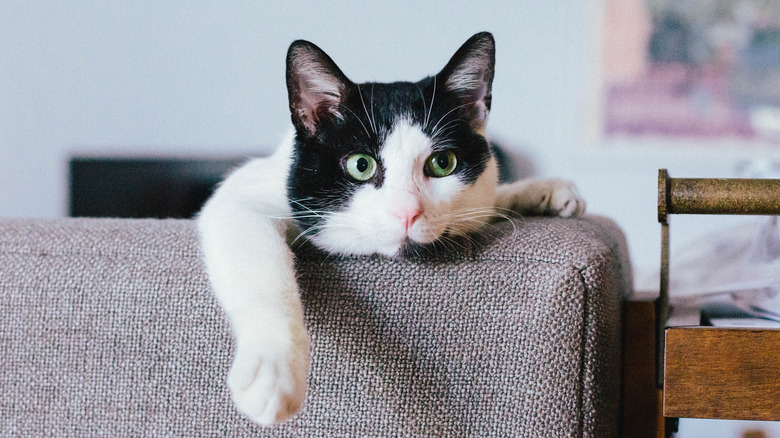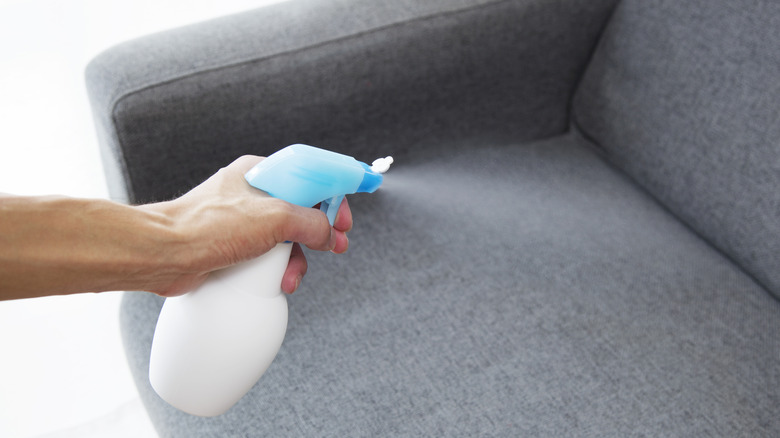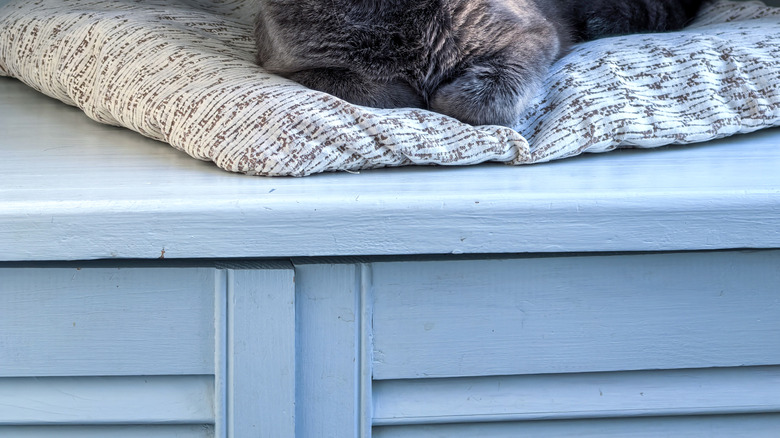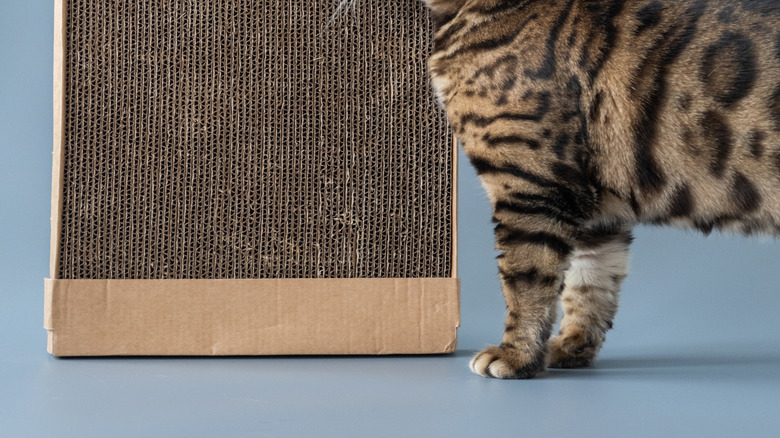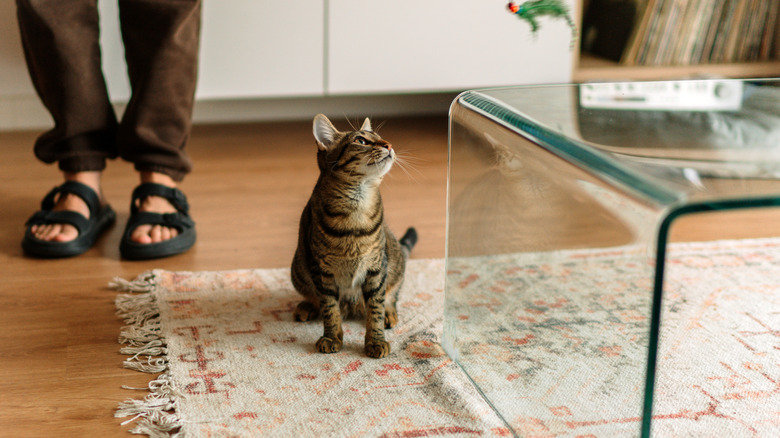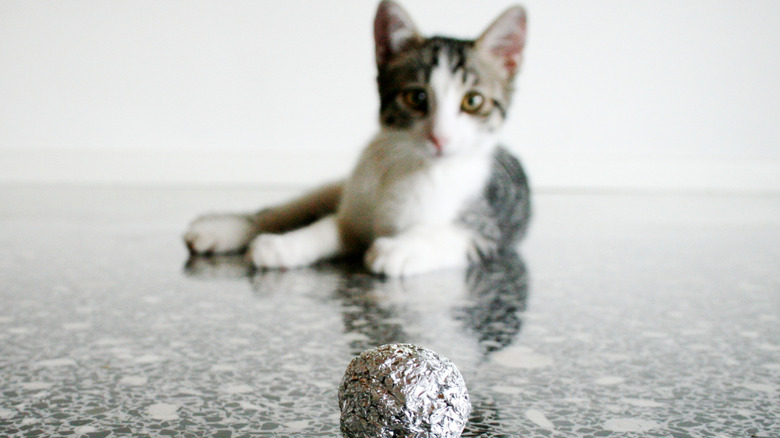5 Ways To Keep Cats Off Furniture With Items You Already Have At Home
We may receive a commission on purchases made from links.
A cat's natural curiosity and willingness to explore every corner of its home can be an endearing trait when they use it to sneak up for a cuddle or a surprise playful pounce. Yet, this can also cause issues in the home when an owner is looking to preserve furniture from scratches or clear of cat hair for those family members with allergies. This can be particularly challenging as a cat's stubbornness to listen can come in equal measure with its desire to get its way.
Each home is different, and each pet parent has a reason for keeping a cat off all or specific furniture. You can buy products to address this issue, like cat deterrent surface sprays, which give a wandering cat reason to pause before claiming a piece of furniture for itself. However, for the resourceful owner, many household items can be repurposed to help deter a cat before having to rely on purchased products. The best thing about simple, homemade solutions to preventing a cat from jumping on furniture is that if one does not work, you can try another or mix up a few to see which works best.
Make a spray using common household ingredients
Pet sprays on Amazon can cost upwards of $20 or more, so not only is making one at home cost-effective, but this way you will know exactly what ingredients go into the spray you use on your furniture and if it is safe for your cat. A combination of equal parts water, white vinegar, and soap in a spray bottle works as a deterrent. Here, you will want a plant-based soap like Pure Castile Liquid Soap to ensure the ingredients don't irritate a cat's (or owner's) skin. In addition, what you don't use in the spray can be used elsewhere.
Some pet parents place citrus peels around houseplants they don't want a cat to access, but leaving peels around is not always ideal with furniture. Thankfully, making your own citrus spray is simple. Using peels from any citrus fruit, like oranges, lemons, or limes, boil them in water for 20 minutes, let the mixture cool, and transfer to a spray bottle. Remember, when spraying anything on fabric, test it on a small patch first to ensure there is no discoloring.
Create a space for them to relax with household items
A new piece of furniture in the home can be an exciting prospect for a kitty to conquer, but sometimes, its obsession can be a sign of having a lack of space to itself. It is crucial for a cat to have height for both physical and mental health. Cats still need places they can jump up on, so when it is interested in a new piece of furniture you don't want it exploring, consider giving it a different place to observe its kingdom from.
You can purchase specific comforts like beds for your kitty if you want it to live the glam lifestyle, but laying down an unused blanket or towel on a shelf can be a cozy little nook to keep it distracted from new furniture while giving it the height it needs. You can look for other ways to enrich a cat's environment, like homemade toys or a view of the outdoors, to make the new space even more of a distraction from furniture. Creating a fun space to relax or explore with household items is also an easy addition to the other options on this list.
Save boxes and make scratching board
For some, the fear of a cat clawing their couch or an armchair is reason enough to have a rule that cats stay off all furniture. However, getting a kitty to stop scratching is unlikely, as its desires are deeply rooted in instinct, from a need to mark territory to keeping its claws clean and sharp. While ensuring a cat has a proper scratching post is essential, you can also make one.
With how many cardboard boxes come in and out of a house, saving some up to create your own scratching post is cost-effective and an environmentally conscious way to repurpose the material. As outlined in the video above from NaamaYM Crafts and DIY, the process is simple, utilizing cardboard boxes and standard household tools. The best part about this design is that it can be set up vertically, which is ideal for a cat who loves to stretch upwards to scratch up furniture; if a cat is scratching up a carpet, you can place it down flat.
Use double-sided or packing tape to keep cats off furniture
Cat paws are highly sensitive because they are filled with nerve endings. When cats use their cute little toe beans to explore the world around them, they can be dissuaded from uncomfortable surfaces, including anything sticky. Laying down double-sided tape on any surface can make it an automatic deterrent. There are many different types of double-sided tape used for various purposes, and many might find they already have some they can use; just ensure it is safe for the intended surface you plan to use it on.
If you don't have double-sided tape, you can just as easily use packing tape by making long strips and folding them over. This can be placed on a surface the cat is jumping on, adding an uncomfortable feeling and making it less likely to jump up again. It can also be used as a deterrent for scratching furniture arms and is perfect for use in tandem with a scratching post if the goal is to keep furniture safe.
Create a crinkly surface with tinfoil
Many cats dislike tinfoil, with a combination of the sound, texture, and reflective surface all potential deterrents for jumping up on surfaces. Taping slightly crumpled tinfoil to furniture or a counter surface can be a quick fix. However, some pet parents note varied success in using aluminum foil to keep a cat off furniture, so while this is an easy fix, it may be the least likely to work. Alternatively, a plastic car mat with pointy nubs for grip can also deter cats from jumping up on a surface, though this may be a rather unsightly addition to a home.
While tinfoil's noise can be a deterrent, owners should avoid methods that involve scaring a cat, such as placing noisy obstacles, spraying them with water or air, or shocking them. Trying to frighten a cat into behavior can be stressful and have adverse effects. Remember, each cat is its own unique bundle of joy, and while some of these may work, others may do little to deter a kitty's curious wanderings. Still, utilizing a practical, homespun solution, or solutions, can help solve the issue of a cat jumping up on furniture without causing unnecessary stress for pet or parent while helping to save money.
